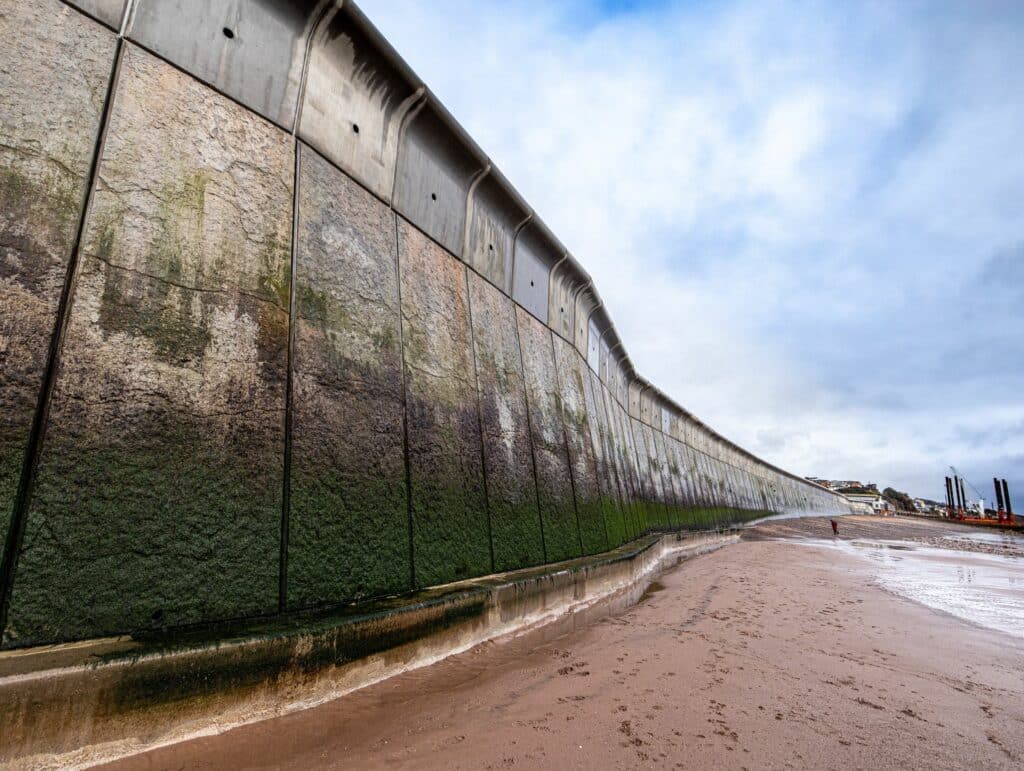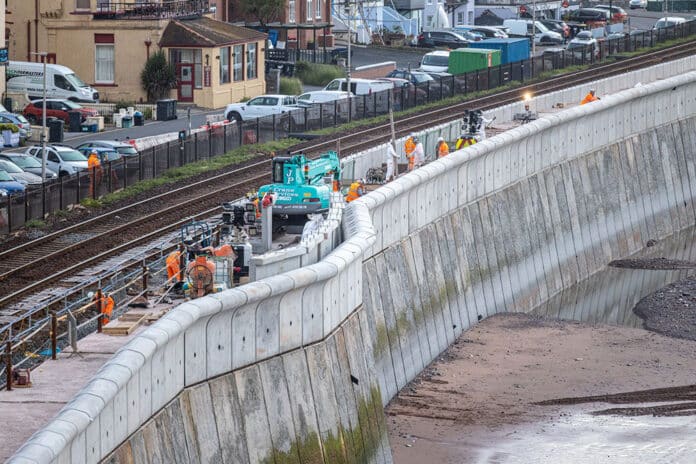In February 2014, a devastating storm struck the south Devon coastline at Dawlish cutting off the only railway line to the south west. Seven years on, a new sea wall that is being built by Network Rail is proving to be effective at protecting the railway and town from rising sea levels and extreme weather.
Following the Government’s commitment to spend £80m on a new sea wall in Dawlish, the Devon town’s coastline is undergoing a mighty transformation.
In May 2019 Network Rail started construction and completed the first section last July. The new, bigger sea wall was officially opened by the Rail Minister last September and runs for 360 metres along Marine Parade west of Dawlish station, giving the iconic stretch of railway line immediate greater resilience against waves that flood the track, leading to potential closures and delays.
Dramatic pictures during construction showed the wall’s effectiveness with waves crashing over the top of the wall where the wave returns had not been installed but successfully being deflected back out to sea, where the curved panels were in place. Further storms since completion of the first phase have seen the track remain protected along this section but still be flooded on the east side of the station, where work on the second section of new sea wall is ongoing.
Work on the second section of the new sea wall began last November and is progressing well. A major aspect of this work involves the use of an innovative eight-legged, self-contained walking jack-up barge, known as a ‘Wavewalker’. Since November, the ‘Wavewalker’ – which is the only one of its kind in Europe – has been used to help deliver the piling at the sea wall.
The ‘Wavewalker’s’ time in Dawlish is soon coming to end with the piling work scheduled to be completed 20 February. Once all the piles have been installed, the next stage of the work will involve ‘scouring’ the piles – to protect against erosion – followed by the start of the installation of the wall panels and concrete backfill.
This second section of sea wall is expected to take around two years to complete and once finished, this 415 metre section which stretches from Coastguard breakwater east of Dawlish station to Colonnade breakwater, will link up with the already completed first section of sea wall at Marine Parade.
By the start of 2023, the completion of this work will increase the resilience of the railway in the south west for at least the next 100 years and ensure communities remain connected via the railway network.
As part of the designs, the new sea wall will also improve passengers’ experience and access at Dawlish station through a new footbridge with lifts, whilst providing local residents and visitors to Dawlish with a high-level, wider and safer promenade and pedestrian access to the beach.
The new sea wall at Dawlish is part of Network Rail’s ongoing efforts since 2014 to improve the resilience of the railway between Dawlish and Teignmouth in Devon, known as the South West Rail Resilience Programme.
Chris Pearce, Network Rail’s interim Western route director, said: “We are really pleased with the progress we have made in Dawlish. Many will remember the significant damage to the railway in 2014 and the impact it had on Dawlish and the wider south west, and the work we are continuing to do in Dawlish will protect the town and region for at least the next 100 years.
“It has been great to see the interest of the local community in our project – particularly the presence of the Wavewalker – which has ensured we’ve managed to continue with the piling at the sea wall despite some of the stormy weather we’ve recently experienced.”
Chris Heaton-Harris, Rail Minister, said: “The damage to the sea wall in Dawlish caused shockwaves across the country back in 2014, and it has been a huge feat of engineering to get the new structure to where it is today.
“I have seen for myself the incredible work that has gone into the first phase of the sea wall, and once completed our investment will provide a resilient railway for generations to come.”
Councillor Andrea Davis, Chair of Peninsula Rail Task Force, said: “For the people of Dawlish, the completed first section of new sea wall and work that is ongoing really does enhance the area, gives that reassurance about protection for the next 100 years and means Dawlish can continue to be a vibrant community.
“There are two million people across the south west peninsula who would be adversely affected if the railway was damaged again by extreme weather, and this is why the work Network Rail is doing is so important.”
Anne Marie Morris, MP for Newton Abbot, commented: “This project is mission critical, not just for Dawlish but for the wider communities across the south west. The progress Network Rail has made is phenomenal and I’ve been incredibly impressed.”
Alison Foden, Mayor of Dawlish, added: “This work is vitally important for Dawlish. We are a seaside town and the railway is one of our unique selling points and is in our history from when Isambard Kingdom Brunel built this beautiful railway.
“The progress Network Rail has made, particularly with the completion of the first section of new sea wall, is brilliant. We now have a real sea wall promenade and people love coming down here.”
It was over 4 and 5 February 2014 that a ferocious storm battered the south Devon coastline in Dawlish causing significant damage to the railway track, leaving thousands of people without power and forcing many local residents to abandon their homes.
The damage to the railway meant communities in 50 towns and cities across the south west peninsula were cut off from the rest of the UK and it would cost £35m to rebuild.
The track reopened in April – just eight weeks after the storm damage – following what the then Prime Minister David Cameron described as “a Herculean effort” whereby a team of 300 Network Rail engineers worked day and night to rebuild the track and restore the railway.
For more information and to follow the latest developments of the construction of the new sea wall at Dawlish, please visit https://www.networkrail.co.uk/running-the-railway/our-routes/western/south-west-rail-resilience-programme/dawlish-sea-wall-section-two/

Photo credit: Network Rail



































 0113 2082620
0113 2082620 info@railbusinessdaily.com
info@railbusinessdaily.com 15 Mariner Court, Wakefield WF4 3FL
15 Mariner Court, Wakefield WF4 3FL

